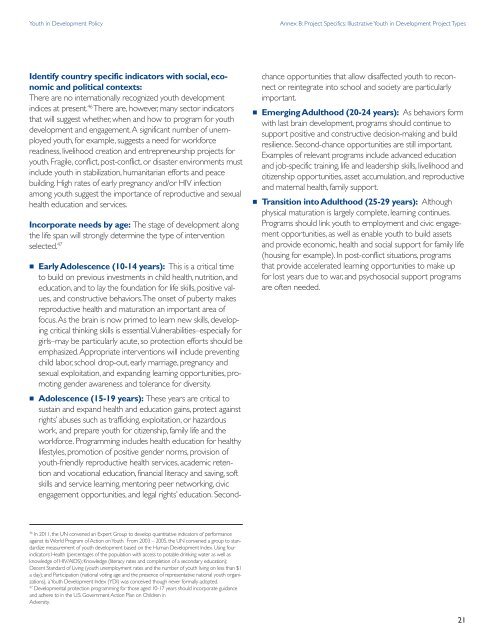YOUTH IN DEVELOPMENT Realizing the Demographic Opportunity USAID POLICY YOUTH
YOUTH IN DEVELOPMENT Realizing the Demographic Opportunity USAID POLICY YOUTH
YOUTH IN DEVELOPMENT Realizing the Demographic Opportunity USAID POLICY YOUTH
Create successful ePaper yourself
Turn your PDF publications into a flip-book with our unique Google optimized e-Paper software.
Youth in Development Policy Annex B: Project Specifics: Illustrative Youth in Development Project Types<br />
Identify country specific indicators with social, economic<br />
and political contexts:<br />
There are no internationally recognized youth development<br />
indices at present. 46 There are, however, many sector indicators<br />
that will suggest whe<strong>the</strong>r, when and how to program for youth<br />
development and engagement.A significant number of unemployed<br />
youth, for example, suggests a need for workforce<br />
readiness, livelihood creation and entrepreneurship projects for<br />
youth. Fragile, conflict, postconflict, or disaster environments must<br />
include youth in stabilization, humanitarian efforts and peace<br />
building. High rates of early pregnancy and/or HIV infection<br />
among youth suggest <strong>the</strong> importance of reproductive and sexual<br />
health education and services.<br />
Incorporate needs by age: The stage of development along<br />
<strong>the</strong> life span will strongly determine <strong>the</strong> type of intervention<br />
selected. 47<br />
■ Early Adolescence (1014 years): This is a critical time<br />
to build on previous investments in child health, nutrition, and<br />
education, and to lay <strong>the</strong> foundation for life skills, positive values,<br />
and constructive behaviors.The onset of puberty makes<br />
reproductive health and maturation an important area of<br />
focus.As <strong>the</strong> brain is now primed to learn new skills, developing<br />
critical thinking skills is essential.Vulnerabilities–especially for<br />
girls–may be particularly acute, so protection efforts should be<br />
emphasized.Appropriate interventions will include preventing<br />
child labor, school dropout, early marriage, pregnancy and<br />
sexual exploitation, and expanding learning opportunities, promoting<br />
gender awareness and tolerance for diversity.<br />
■ Adolescence (1519 years): These years are critical to<br />
sustain and expand health and education gains, protect against<br />
rights’ abuses such as trafficking, exploitation, or hazardous<br />
work, and prepare youth for citizenship, family life and <strong>the</strong><br />
workforce. Programming includes health education for healthy<br />
lifestyles, promotion of positive gender norms, provision of<br />
youthfriendly reproductive health services, academic retention<br />
and vocational education, financial literacy and saving, soft<br />
skills and service learning, mentoring peer networking, civic<br />
engagement opportunities, and legal rights’ education. Second<br />
46 In 2011, <strong>the</strong> UN convened an Expert Group to develop quantitative indicators of performance<br />
against its World Program of Action onYouth. From 2003 – 2005, <strong>the</strong> UN convened a group to standardize<br />
measurement of youth development based on <strong>the</strong> Human Development Index. Using four<br />
indicators: Health (percentages of <strong>the</strong> population with access to potable drinking water as well as<br />
knowledge of HIV/AIDS); Knowledge (literacy rates and completion of a secondary education);<br />
Decent Standard of Living (youth unemployment rates and <strong>the</strong> number of youth living on less than $1<br />
a day); and Participation (national voting age and <strong>the</strong> presence of representative national youth organizations),<br />
aYouth Development Index (YDI) was conceived though never formally adopted.<br />
47 Developmental protection programming for those aged 1017 years should incorporate guidance<br />
and adhere to in <strong>the</strong> U.S. Government Action Plan on Children in<br />
Adversity.<br />
chance opportunities that allow disaffected youth to reconnect<br />
or reintegrate into school and society are particularly<br />
important.<br />
■ Emerging Adulthood (2024 years): As behaviors form<br />
with last brain development, programs should continue to<br />
support positive and constructive decisionmaking and build<br />
resilience. Secondchance opportunities are still important.<br />
Examples of relevant programs include advanced education<br />
and jobspecific training, life and leadership skills, livelihood and<br />
citizenship opportunities, asset accumulation, and reproductive<br />
and maternal health, family support.<br />
■ Transition into Adulthood (2529 years): Although<br />
physical maturation is largely complete, learning continues.<br />
Programs should link youth to employment and civic engagement<br />
opportunities, as well as enable youth to build assets<br />
and provide economic, health and social support for family life<br />
(housing for example). In postconflict situations, programs<br />
that provide accelerated learning opportunities to make up<br />
for lost years due to war, and psychosocial support programs<br />
are often needed.<br />
21


